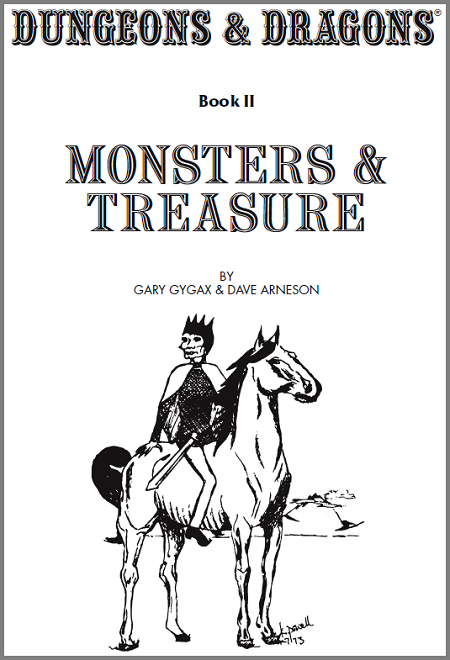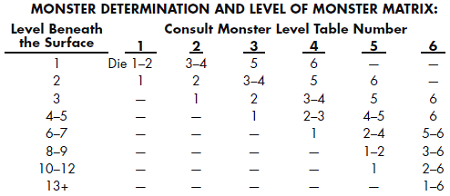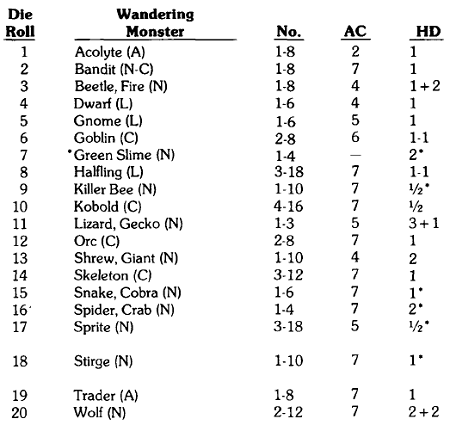While I was comparing dungeon treasure stocking in B/X D&D and Labyrinth Lord, I noticed something in OD&D that surprised me: The way OD&D handles wandering monsters is delightfully unforgiving.
At a glance, B/X looked pretty different in this regard, so I thought I’d compare the two. Let’s just look at level 1 in both systems, and let’s assume the party is composed of level 1 PCs.
I’ll also assume that monsters with X+Y HD, like hobgoblins (1+1/2 in OD&D, 1+1 in B/X) count as 2 HD monsters. (This assumption is borne out by both systems, which list hobgoblins on their respective level 2 tables.)

Das tables
Here’s the wandering monster matrix from OD&D‘s (paid link) Book III:

In B/X each dungeon level just has its own table, which includes a mix of monster HD values. Here’s the analogous table from the B/X Basic Set (paid link):

OD&D wandering monsters
In OD&D, a party exploring level 1 of the dungeon can encounter wandering monsters with a range of HD values.
The Monster Level tables roughly map 1:1 to HD, but not universally. For example, there’s a 5 HD monster, the ochre jelly, on the level 3 monster table. There are also monsters with suggested values, but no actual entries; giant animals fall into this category.[1]
But for our purposes, “roughly” is good enough. With that in mind, the chances of bumping into different levels — hit dice, more or less — of monsters look like this:
- Monster Level 1 list, mainly 1 HD or lower: 33.33%
- Monster Level 2 list, mainly 2 HD: 33.33%
- Monster Level 3 list, mainly 3 HD: 16.67%
- Monster Level 4 list, mainly 4 HD: 16.67%
One-third of the time, you’ll meet monsters whose HD match your level. Another third of the time, they’ll be 1 HD higher than you. The remaining third of your encounters will be with monsters 2 HD or 3 HD higher than you.
And that level 4 monster table is going to wreck your shit: wraiths, ogres, lycanthropes — if you’re not cautious and willing to run, be prepared to die instead.
B/X wandering monsters
In B/X, things are a bit different:
- 1 HD or lower: 70%
- 2 HD: 25%
- 3 HD: 5%
The chance of encountering a 2 HD monster is roughly the same (25% vs. OD&D’s 33.33%), but what’s missing? Except for one 3 HD critter (the giant gecko), what’s missing is 3 HD and 4 HD monsters — which are encountered fully one-third of the time in OD&D!
The dungeon of B/X, at least on level 1, is a much tamer place than its OD&D counterpart. Wandering monsters still spell trouble, but not nearly as much trouble.
But wait, there’s more
You know what else changed between 1974 and 1981?[2] How often you check for wandering monsters. (The chance of an encounter, 1 in 6, is the same.)
In OD&D, it’s every turn. In B/X, it’s every two turns.
So not only is the B/X party unlikely to meet a 3 HD monster (5% chance) and guaranteed not to bump into any 4 HD monsters, they’re also going to have half as many random encounters overall. These are completely different dungeons.
Time is a resource in old-school D&D dungeon crawls in large part because of wandering monster checks, but OD&D really squeezes the ol’ temporal vice in this regard. If you don’t get in, grab some loot, and get out pretty quick, you’re playing with fire.
I’ve never played OD&D, but my interest in it has been growing over the past couple of years. This difference clinches it, though: I need to play some OD&D! I want to see this style of dungeon in action, rather than just in percentages.
A wild aside appears!
As an aside, while I’m normally a print guy and the photos I use in posts reflect that preference, I went with screenshots from my PDF copies this time around. This is partly because my OD&D set is in storage, but it’s also because I’ve been working from the PDFs a lot lately.
While I prefer the old covers, the layout and clarity of the OD&D PDFs (paid link) is fantastic. The quality of the B/X PDFs (paid link) is also high. Both have been a good investment, especially when I need to search for things while comparing editions.
[1] And then there’s Supplement I: Greyhawk (paid link), which removes the “optionally usable “Martian” animals such as Apts, Banths, Thoats, etc.” and adds new monsters to every list, making the picture fuzzier still. I’m sticking with “good enough.”
[2] Yes, I’m leaving out the Holmes Basic set, but only because my copy is in storage and I don’t have it in PDF. I’d love to see whether Holmes looks more like OD&D or B/X in this regard.

Something else to consider as well… OD&D’s wandering monsters don’t usually have treasure. I can’t remember how B/X adjudicated treasure for wandering monsters, but in OD&D, they were deadly and a waste of resources for taking on the guardians of treasure.
Really? I can’t find that anywhere in the LBBs, but I may be looking in the wrong places.
I thought wandering monsters in both editions had their listed treasure (or kept it in their nearby lairs, if not portable, etc.).
No, with the LBBs, when you rolled a wandering monster out in the wilderness, you checked against “percent in lair.” If that roll was under the number given, the lair was nearby, and could be discovered, treasure and all. Otherwise, no treasure, unless, like giants, it was noted in the description that they carried some around.
Oh, likewise in dungeons, except the books assume you’ve already populated the dungeon with monsters and treasure. The wandering monsters in a dungeon were just to waste resources on ill-planned expeditions.
It’s pretty well tucked-away, but I did find this reference! And I can’t find a counter-example where wandering dungeon critters are noted as having treasure.
Alongside the brutal math of checking for encounters once per turn, and having a good chance of higher-level encounters, OD&D dungeons seem exceptionally deadly.
Nice work, thanks. Your blog is a pleasing recent discovery for me. Keep up the good work! I grabbed the OD&D Wandering Monsters Table poster somebody made a few years back and hung it on the wall in my gaming room where I could consult it during play. Still not sure I am happy with any frequency rate that is out there, however — I generally prefer trigger events to dominate, with a little randomness on the side. Rate appropriateness also would seem to really depend on the dungeon design features in play in any situation (e.g., ratio of empty rooms, etc.).
Thanks! I’m glad you’re digging Yore. :-)